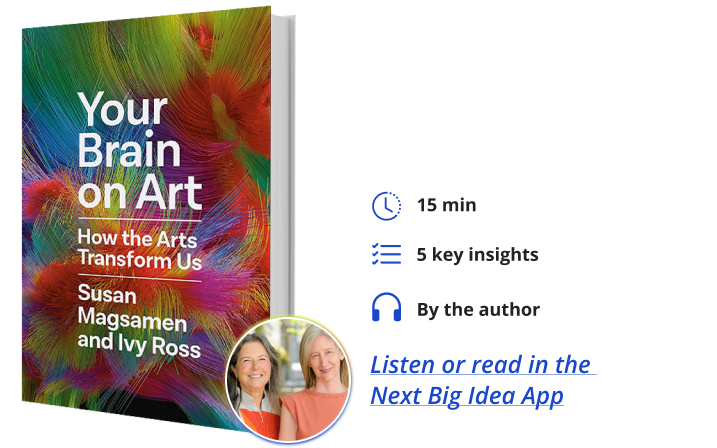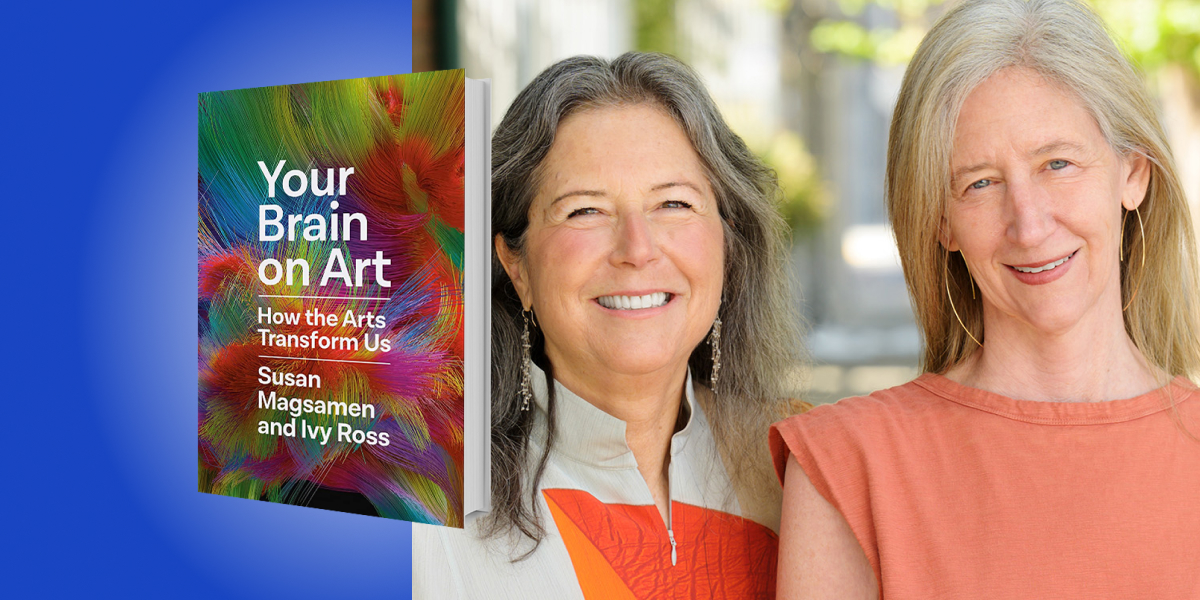Ivy Ross is the Vice President of hardware design at Google and has a background in art and design. Previously, Ivy has held executive positions spanning from the head of product design and development to chief marketing officer and presidencies with several companies, including Calvin Klein, Swatch, Coach, Mattel, Art.com, Bausch & Lomb, and Gap.
Susan Magsamen is the founder and director of the International Arts + Mind Lab, Center for Applied Neuroaesthetics at Johns Hopkins University School of Medicine, and the co-director of the NeuroArts Blueprint with the Aspen Institute.
Below, Ivy and Susan share 5 key insights from their new book, Your Brain on Art: How the Arts Transform Us. Listen to the audio version—read by Ivy and Susan—in the Next Big Idea App.

1. We have the proof.
Over the last 20 years, advances in technology have enabled us to get inside our heads. One result is a new field called neuroaesthetics, or neuro arts for short. Neuro arts is the study of how the arts and aesthetics measurably change your brain and body, and how this knowledge can be translated into practices that advance health and well-being. The field brings together basic and social sciences with the arts to create a highly interdisciplinary approach.
Research is proving that we are literally wired for art, and these experiences alter a complex physiological network of interconnected, neurological, and biological systems. This includes sensory systems, cognition, immune and endocrine, circulatory, respiratory, reward, and motor systems, to name just a few. The arts are one of the best ways to enliven these neurological systems. On a very basic level, how these systems connect and change with the arts happens through a process called neuroplasticity.
Each of us is born with 100 billion neurons that connect at the synaptic level. You have quadrillions of synaptic connections in your brain, creating endless circuits and neural pathways. These pathways underlie your body’s movements, emotions, and memory—basically, everything you do. Researchers are discovering that through highly salient experiences, like the arts and aesthetics, these quadrillions of new synapses that form in your brain create a repository of stored knowledge and responses that are as unique as your fingerprints. No one else, not a single person, has your exact brain.
Your brain is a meaning-making machine. It connects the dots, finds patterns, and then builds neural pathways all of the time. This happens in large part through the default mode network, which is now believed to be where the neurological basis for the self is housed. A great example of neuroplasticity in action can be found in the spaces and places we inhabit.
In the 1960s, neuroscientist Marion Diamond designed an experiment using rats. She created three different sensory physical spaces, including one that was highly enriched. After just several weeks, she dissected the rat’s brains and found that the cerebral cortex, the outer layer of the brain from the enriched environment group, had increased in thickness by 6 percent, as compared to those in the less sensorial groups that had actually lost brain mass. This was the first time anyone had ever seen structural changes in an animal’s brain based on different kinds of environmental experiences.
Studies have now duplicated this work with people using non-invasive EEG technology with similar results. The implications for creating healthier and more creative environments for all of us are profound.
2. There’s an art for that.
Arts and aesthetics are not a “nice to have,” they are essential to our very survival. Evolutionary biologist E.O. Wilson shared that the evolutionary underpinning of the arts as prerequisites for human growth and development has continued to expand throughout millennia. The bottom line is the arts positively impact every area of your life, including your physical and mental health, learning, flourishing, and community building.
Some fascinating findings include: 20 minutes a day of art is as beneficial as getting enough exercise and sleep. After 45 minutes of practicing art, the stress hormone cortisol is reduced. Playing music increases synapses and gray matter, which supports cognitive skills. Chronic pain can be managed through dance and virtual reality. One or more art experiences a month can extend your life by ten years.
“20 minutes a day of art is as beneficial as getting enough exercise and sleep.”
Now, for your mental health, give these activities a try. Write down a secret, even if you don’t share it with anyone else, says researcher James Pennebaker. It’s shown to relieve stress and cognitive load. Work with your hands, including using materials like clay, yarn, or even soil. It turns out that your hands stimulate skin and nerve endings and ignite the body’s internal sensory receptors, making you feel instantly attentive and focused. Singing and humming activate the vagus nerve, engaging the parasympathetic systems to make you feel good. Reading poetry lights up some of the same parts of the brain as listening to music, stimulating the brain’s primary reward circuitry. Try using tuning forks in the key of C and G held up to your ears. Sound is an excellent tool to help regulate homeostasis. The frequency of sound instantly taps into what lies underneath conscious recognition, literally changing the vibrations in your body.
In physical health, the findings are also significant. Singing is helping people with dementia recall memories and reconnect to family and friends, improving cognition and quality of life. Light and sound alter the progression of dementia. Dance is helping people with Parkinson’s disease, strokes, and other motor-based challenges to improve gait, cognition, sleep, and mood. Chronic pain is best managed by dance, and even virtual reality.
A multi-country study is showing the value of mothers singing to their babies to release oxytocin and reduce postpartum depression. Healthcare practitioners are now prescribing nature pills based on studies that show time outdoors has a measurable effect on regulating our physiological systems. Nature is the most neuroaesthetic environment, as it offers us the sensation of color, texture, sound, smell, temperature, and shape. Believe it or not, museum visits are being prescribed by doctors to engage sensory perceptions to increase cognitive skills.
3. Anywhere, anytime, anybody.
The power of the arts is accessible to you right now, anywhere, anytime, offering immediate dividends for individuals and communities. Researchers have debunked a huge myth; you don’t have to be good at art or a skilled artist for the arts to have a significant impact. Making and beholding the arts are not dependent on resources, age, or ability. You can hum, doodle, write, read, listen to music, or color. Studies show that those of us who are engaged in the arts and crafts have lower levels of mental distress, and we are also experiencing higher levels of mental functioning and life satisfaction.
Something as simple as doodling activates the prefrontal cortex, the area of the brain that helps us focus and find meaning in sensory information. Doodling, coloring, or simple drawing like stick figures, increases blood flow and triggers feelings of pleasure and reward. It turns out that doodlers are more analytical, retain information better, and are better focused than their non-doodling colleagues. Studies show that dancing for even just 15 minutes reduces stress, anxiety, and depression, and increases feel-good hormones, including endorphins, serotonin, and dopamine, to name a few. Dancing is highly effective in creating new neural connections.
Research is proving that the process of painting and drawing enhances self-knowledge and these insights transfer to other areas of our lives. Some examples include: first responders and active military doing woodworking and welding to confront symptoms of PTSD and ongoing trauma. College students are forming knitting circles, resulting in stronger social connections, maintaining focus, reducing anxiety, and managing stress.
“The success of our species comes down to this; art creates culture, culture creates community, and community creates humanity.”
The arts and aesthetics experiences also helped us flourish by engaging our curiosity and wonder, introducing all creativity, novelty, and surprise. The World Bank says that without strong and diverse cultures, economies can’t grow. Without these two things, inner healing, health, and well-being suffer and opportunities are lost. We are ultra-social creatures who biologically evolve to belong to something greater than ourselves. The success of our species comes down to this; art creates culture, culture creates community, and community creates humanity. Storytelling, dancing, singing, and so many other art forms are all part of our evolutionary DNA.
4. The future of the arts is immersive and sustainable.
Immersive, interactive exhibitions and virtual reality are dissolving the boundaries between art and viewers, engaging our senses and creating strong emotional reactions. We are seeing expansive growth of immersive arts that are creating a new form of expression, and it’s an exciting frontier. Even though the first virtual reality devices emerged in the late 1950s, with a first device called Sensorama, researchers are just beginning to understand the impact of highly immersive experiences on our brains and bodies.
But we do know some things. Immersive experiences activate visual, auditory, and haptic-induced sensations, enhancing perception, motor behavior, and sensory-motor adaptation. A robust immersive experience makes your brain respond as though it is really happening. The only difference between real and virtual worlds is the prior knowledge you have that when you see a virtual environment, it is not real, allowing you to act as if it really is, but without the stress. The implications of immersive arts will impact health, education, and other sectors of society. For example, it’s estimated that as many as 350 million adults around the globe live with ADHD, and children who have ADHD are often labeled as having behavioral problems in the classroom.
Adam Gazzaley at UCSF understood that our capacity to pay attention is critical to what we can accomplish in our lives, and he started to research what was happening in the brain of people with ADHD. The result was an immersive video game. He knew that the best way to stimulate neuroplasticity was through an immersive experience, but he needed to selectively target neural networks in such a way that they created an improved attention span.
“Immersive experiences activate visual, auditory, and haptic-induced sensations, enhancing perception, motor behavior, and sensory-motor adaptation.”
Video game design and augmented reality are dynamic aesthetic enhancers that create strong emotional reactions to the narrative and your role in the story. Using these sticky neurological attributes, he came up with a way to use these rich stories to support and build the brain’s capacity to pay attention through what he calls a closed-loop system. The game starts out easy and gets harder over time as your attention capacity improves. Happily, Adam and his team found that the attention improvements happened in the game, but more importantly, outside of the game as well.
The neuro arts field is growing around the world. Research is fueling policies to ensure sustainability and viable practices in the future. The marriage of science, technology, and the arts is opening the door to new forms of innovation.
5. Change your lens, change your world.
We are standing on the verge of a cultural shift in which the arts can deliver potent, accessible, proven health and well-being solutions to billions of people. We have been optimizing for productivity since the Industrial Revolution, pushing the arts aside or making them a luxury, thinking that the focus on productivity would make us happy, but it isn’t.
Incorporating the arts and aesthetics into your life is like turning the aperture on a kaleidoscope. Changing your lens in a small way results in a new way to see and be in the world. Think of the arts as an aesthetic mindset framework that incorporates four core components: curiosity, playful exploration, sensory awareness, and passion for making and beholding.
To listen to the audio version read by co-authors Susan Magsamen and Ivy Ross, download the Next Big Idea App today:































